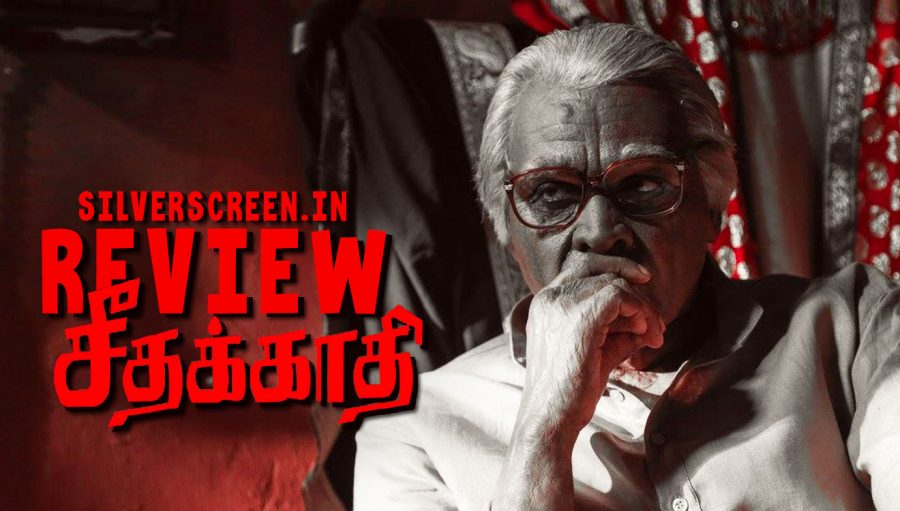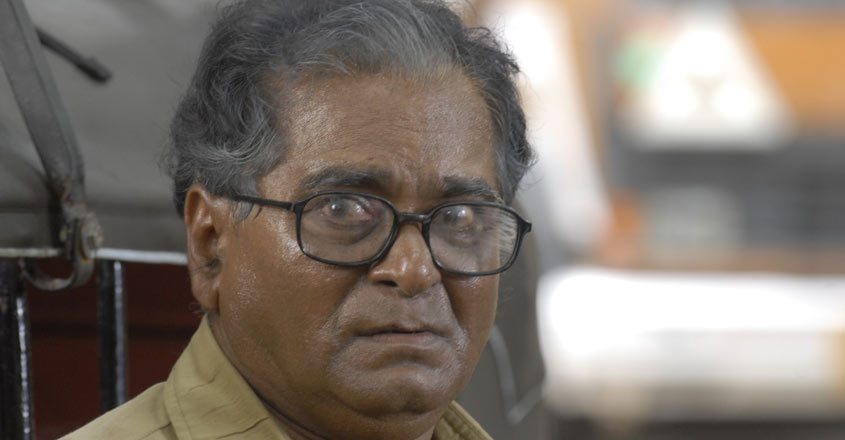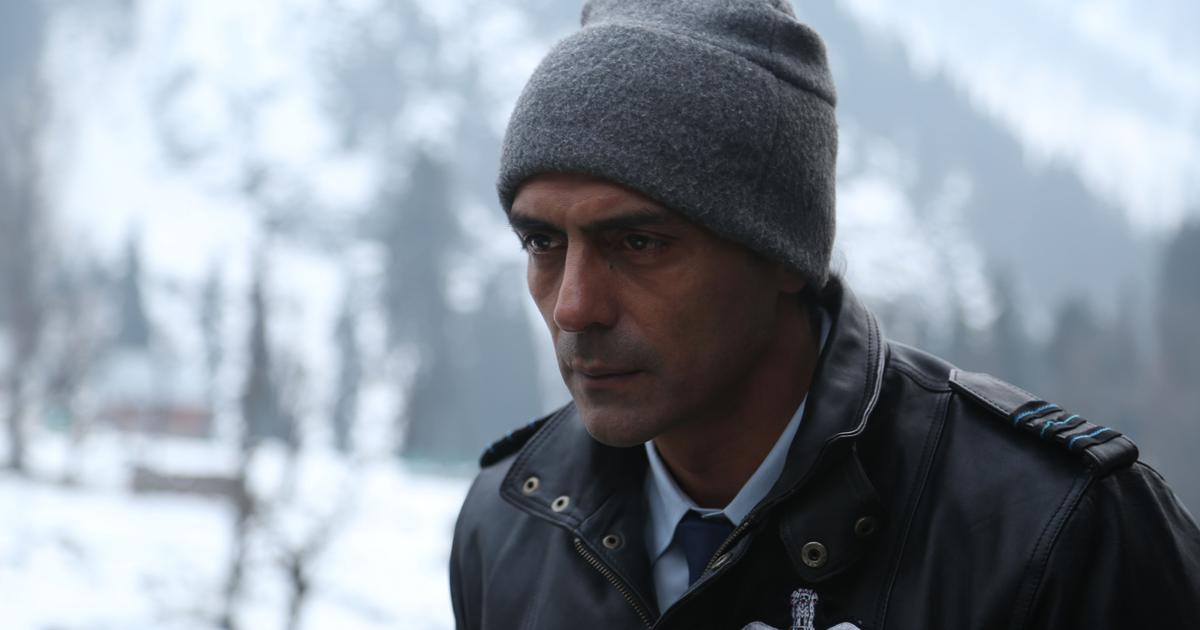Director: Balaji Tharaneetharan
Cast: Vijay Sethupathi, Mouli, Archana, Gayathri
Composer: Govind Vasantha
In Balaji Tharaneetharan’s Seethakaathi, people who champion art get the respect they deserve. This is underlined in a scene that lasts for only a few seconds, in the most throwaway fashion. Someone delivers a piece of information to Parasuraman (Mouli) while seated on a chair in front of a ladder. There is a lot of theatre-related sets and prop work going on around him. Parasuraman has been in this stage troupe for as long as he has been alive. A worker climbs the ladder to fix something and it dances on shaky footing. The seated Parasuraman gets out of his chair to hold the ladder so that the handyman can do his job without worrying about a ghastly fall. This is the kind of care for art and the artiste – down to the most minor contributor working behind the scene – that Tharaneetharan wants to highlight in his film. Parasuraman is the emotional core of the troupe and to an extent, this film. He is also the upholder of the other personification in the film – the artiste, the actor extraordinaire Ayya Adimoolam (Vijay Sethupathi), his childhood friend and confidant.
It is a mistake to count Seethakaathi as a satire because Tharaneetharan wants us to take this very seriously. There are no scenes where its conceit is exaggerated, it is all almost too close to reality to be billed as satire. Whatever little satire exists in Seethakaathi, all of them happen in the films within the film. That’s the point Tharaneetharan keeps driving at – the trivialization of art as it exists in the mainstream today. This is a film that works like a companion piece to Alejandro Gonzalez Inarritu’s Birdman and Kamal Haasan’s Uttama Villain (in Seethakaathi, there is a subplot where a form of selling out contributes towards someone’s brain tumour treatment). The former dealt with the actor as a sell-out and the latter dealt with the mortality of a star. Both of those films – from great artistes – shared themes and concerns, and Seethakaathi joins that list. Like how Riggan Thomson in Birdman becomes Birdman and flies around, Ayya devises a fantastical element to his existence to propagate his art.
It’s worth noting that the artiste behind Seethakaathi doesn’t sacrifice his art. The writing and direction here are positively cinematic. Even the stage plays are filmed in such a manner. There is a single shot of about ten minutes with Ayya Adimoolam as Aurangazeb, contemplating the sins of his past and his death. Ayya is on stage but Tharaneetharan’s camera has a quiet but kinetic energy from different angles.
Soon after the play, Ayya reminisces his old days performing for a large audience and this play in present day, with the numbers hardly touching two digits in front of a sea of empty seats. The long take goes from the stage to other actors removing their makeup and costume, and finally rests on Ayya, in a chair. Something about serpentine backstage and green rooms that charms filmmakers into going for single takes. With the greasepaint off, he is contemplating father time with a calendar hanging behind him next to his wig from Satyavan-Savitri that a younger Adimoolam used to perform.
There is a moment when Parasuraman realises the fantastical element conjured by Ayya. We see Parasuraman, statuesque and agape, while Tharaneetharan manipulates (cinematography by Saraskanth TK) the depth of field behind him. It pulls us – along with Parasuraman – out of a reality and into something otherworldly. And just like his forefathers, Inarritu and Haasan, Balaji Tharaneetharan too goes for mirrors and reflections in several shots. Ayya’s wife and daughter’s reaction to the news from Parasuraman is filmed by their reflection. An actor loses his talisman and becomes a pale shadow of his past, with this very moment captured in his reflection.
Seethakaathi is essentially a giant middle finger to the capricious whims and fancies of the Tamil film industry. Like how an unsuccessful, scorned writer-director files a case on a popular film or its producer/director, not to mention its value as a publicity vehicle. Imagine art or the artiste as a franchise, leased to one and all, for it helps grow money on trees. It wants to ask questions of the actor who is a sell-out, who sacrifices his art in order to gain a toxic following that the audience never asked of him. One of the films is even titled ‘Aanavam’ – ego. A wannabe actor in the end declares that he won’t act even at gunpoint, when a very simple performance is expected of him.
Balaji Tharaneetharan comes up with the most elegant use of ullankai nellikani (and its larger themes related to the Hastamalaka story) in this scene. A scene from the film within the film neatly establishes how most of these films are nothing but upholders of patriarchy. It wants to ask questions of the producers and filmmakers who take the audience for granted, and it doesn’t shy away from indicting the audience either. Even Parasuraman and Ayya’s family are not spared, for having milked Ayya’s talents. There is a huge turmoil within the Tamil Film Producers’ Council even as Seethakaathi releases today. And in the film, Tharaneetharan shows up this organisation as the joke that it is.
Seethakaathi is a film where even the metaphor is flesh and blood, which is why the casting of Vijay Sethupathi is its most honest endeavor. The reflexive nature of this film begins with the casting for Ayya Adimoolam. This is a film that takes pot-shots at the actor (or non-actor) in service of his star status. The last of the breed of stars who went the other way around, performing in service of their art and thereby paving way for their star status, were Kamal Haasan and Rajinikanth. And after all these years, we have Vijay Sethupathi, a worthy successor to that trajectory.
Recommended
Sethupathi has had his share of films like ‘Aanavam’ but he is constantly in quest for reinvention, servicing the actor in him while reaping the rewards of a star. No one has attempted this in decades, at least not since the two giants of Tamil cinema and Seethakaathi is another solid evidence in Sethupathi’s filmography. There is a scene where Ayya holds over a post-performance meeting and an actor – Saravanan – tells him that he’ll act just the way Ayya has taught him. Ayya has only one advice – that Saravanan should act like Saravanan. Not like Ayya.
*****
The Seethakaathi review is a Silverscreen original article. It was not paid for or commissioned by anyone associated with the film. Silverscreen.in and its writers do not have any commercial relationship with movies that are reviewed on the site.



